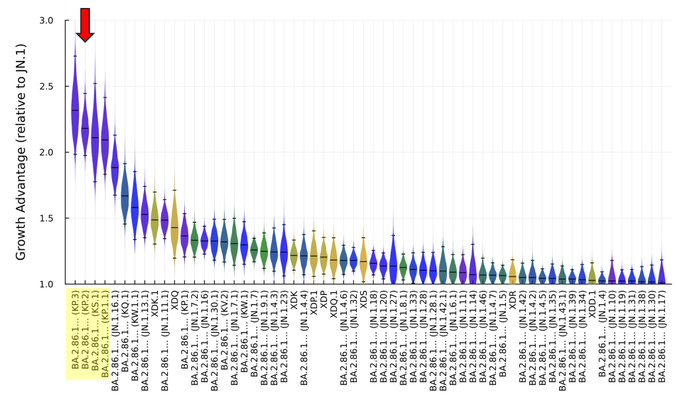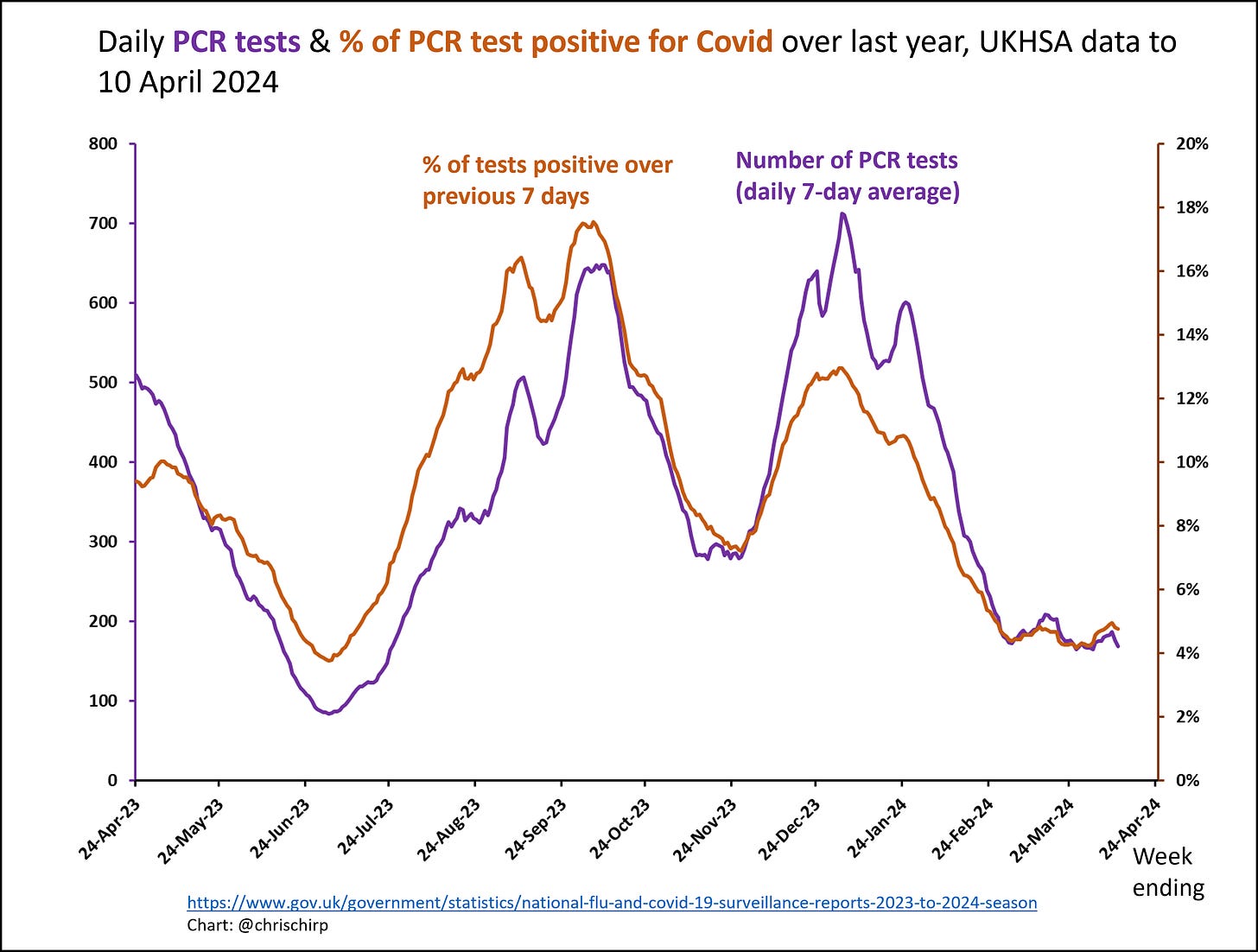Covid levels remain low but new variants are coming, as is bird flu
Christina Pagel on where we are and where we are going.
This was originally posted on Christina’s substack.
********************************************************************************
There is a lot less Covid data around now, but what there is shows that levels of Covid remain low in the UK. That said, I do expect prevalence to increase in the coming weeks as we see the arrival of new variants that seem to be replacing the JN.1 variant that caused the Christmas 2023 wave. We must also prepare for the next pandemic, with outbreaks of Avian Flu (H5N1) in mammals becoming increasingly concerning.
Current levels of Covid in the UK
Hospital data
NHS England are now publishing hospital admissions with Covid only monthly, but UKHSA is still producing weekly measures of hospital admissions with Covid (and flu and RSV) per 100,000 people. The most recent data goes up to 12 April and shows flat and low admissions since the end of the recent winter wave, which was driven by the rise of the JN.1 variant. The other main respiratory viruses (Flu and RSV) are now at very low levels.
Similarly the numbers of daily PCR tests (almost exclusively in hospitals) and the proportion of people testing positive on PCR have stayed steady since the end of February. Since testing protocols have not changed over the last year, it is fair to say that both the number of people admitted to hospital with respiratory symtpoms (and so triggering a PCR test), and the numbers of Covid patients in hospital, are as low as they’ve been since last summer (as indicated both by Covid admission rates and the % of people testing positive in hospital).
Wastewater data
We do not have any current measures of levels of Covid in the community in England since the ONS Winter Infection Survey ended in early March 2024. However, many countries are monitoring community levels using wastewater data, which is not affected by people’s likelihood of either testing for Covid or the likelihood of a positive test making it into official case statistics.
The closest wastewater monitoring country is Scotland. Data up to early April this year shows the same picture as English hospital admissions - low circulating levels of the virus. Other European countries (Denmark, Finland, Austria, Netherlands, Germany) are also continuing to see low and steady levels following the winter wave.
Given the data from hospitals in England and the wasterwater data (which is a very good indicator of levels of Covid in the community) from nearby countries, we can infer that Covid levels remained low in the community in England as of early April.
A new Covid wave
However, it is likely we are about to enter a new wave of infections due to the global increase of new subvariants of the current dominant variant JN.1. Essentially, JN.1 has mutated further and several of its children have found mutations that help them spread much faster than their parent.

Together these are called the FLiRT group of variants (you can read all about them on Eric Topol’s substack post) and they are about 25% of sequenced cases in UK currently and growing. In the US, the wave is forecast to start around May, but how large it will get is unknown. When the JN.1 wave hit around the world last December, it was significantly different to previous circulating variants. It caused a substantial wave but infections were lower than then arrival of Omicron in December 2021 and severe acute illness (as judged by hospital admissions and deaths) was much lower. Since these new FLiRT offshoots are more similar to JN.1, and we are heading into summer, hopefully any wave caused by these new subvariants will be smaller .
That said, some of these FLiRT variants (KP.2 and KP.3) have rapidly reached dominance in India. While testing is sporadic and case numbers are not reliable, there has been a notable increase in reported cases in Kerala. So I do think it’s unlikely that the UK will avoid a wave entirely.
Certainly, those eligible should take up the spring booster offer and unfortunately any increase infections, will mean some increase in new Long Covid and severe illness.
The next pandemic
Covid remains a serious disease, and there needs to be further urgent research into better, longer lasting vaccines; effective treatments for (and prevention of) Long Covid; and the implications of repeated Covid infection on longer term health porblems such as heart issues, diabetes, cognitive function.
But, looking ahead, I (along with many others) am growing increasingly concerned by the spread of Avian Flu (H5N1). Last week, the WHO warned of its potential to cause a new pandemic and most (57%) experts polled in a study by Cologne University believed it would be the cause of the next global outbreak of serious infection disease. Avian Flu has been racing through the global bird population with devastating impact since 2020, and has been documented in other animal species, such as seals and cats. There have been increasing signs of sufficient mammal to mammal transmission to cause concern for a jump to significant human to human transmission (Tom Peacock covers the evidence in this brilliant recent thread).
Most recently, the concern has been around H5N1 infected cows in the US, where the CDC reports that outbreaks in dairy cattle have been documented across eight states. It’s not clear yet whether the cows are spreading it directly to each other or by some other mechanism (including potentially contaminated machinery), but cow-to-cow transmission is certainly one possible explanation. Scientists are frustrated by the lack of genetic or epidemiological data emerging from the US outbreaks and by an overly cautious approach to testing humans exposed to infected cattle.
The UK should be putting significant resources into preparing for the next airborne pandemic. This involves both learning about what worked and did not work for Covid, but also recognising now where the differences are between a Coronavirus and Flu response and what that means in terms of prevention and response. For instance, contact tracing is generally not very effective for Flu, because people become infectious too quickly after exposure (so you can’t reach contacts in time to prevent onward transmission). However, clean air strategies, high quality masks and reducing indoor crowds should all remain effective. Ramping up plans for testing and surveillance seems a no-brainer.
There are many viruses out there with the potential to cause deadly pandemics and we must be prepared.






